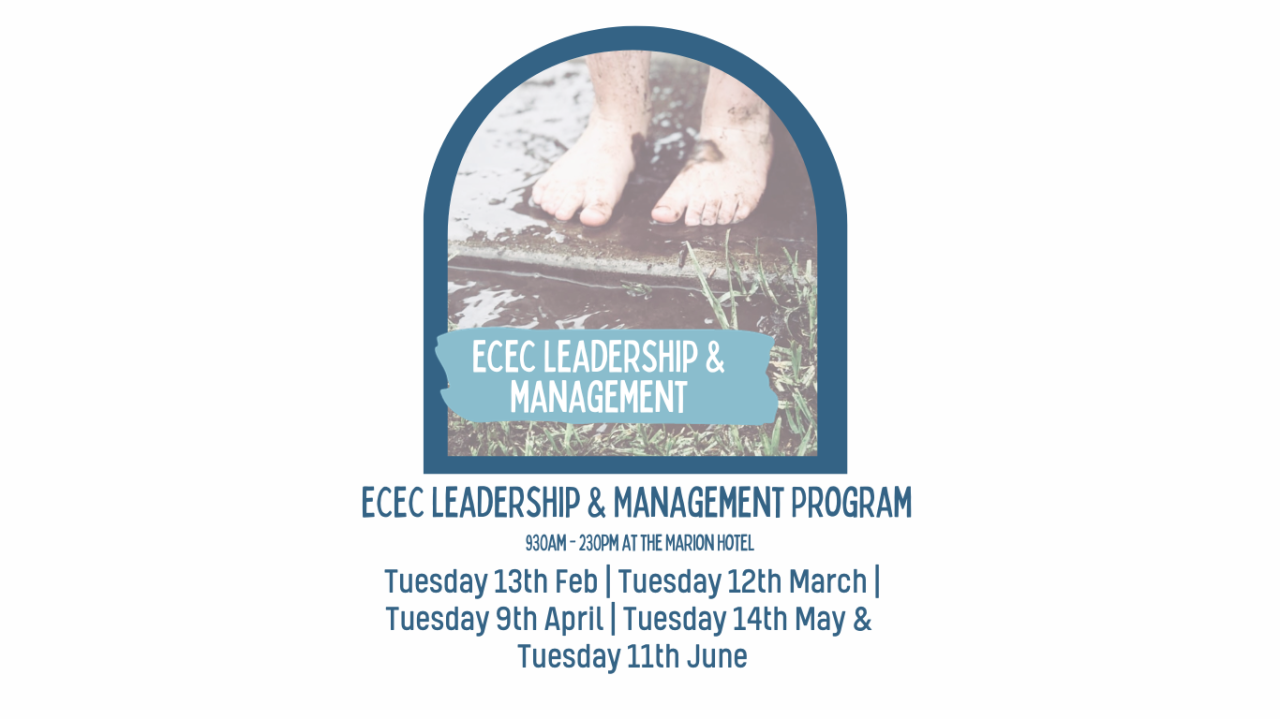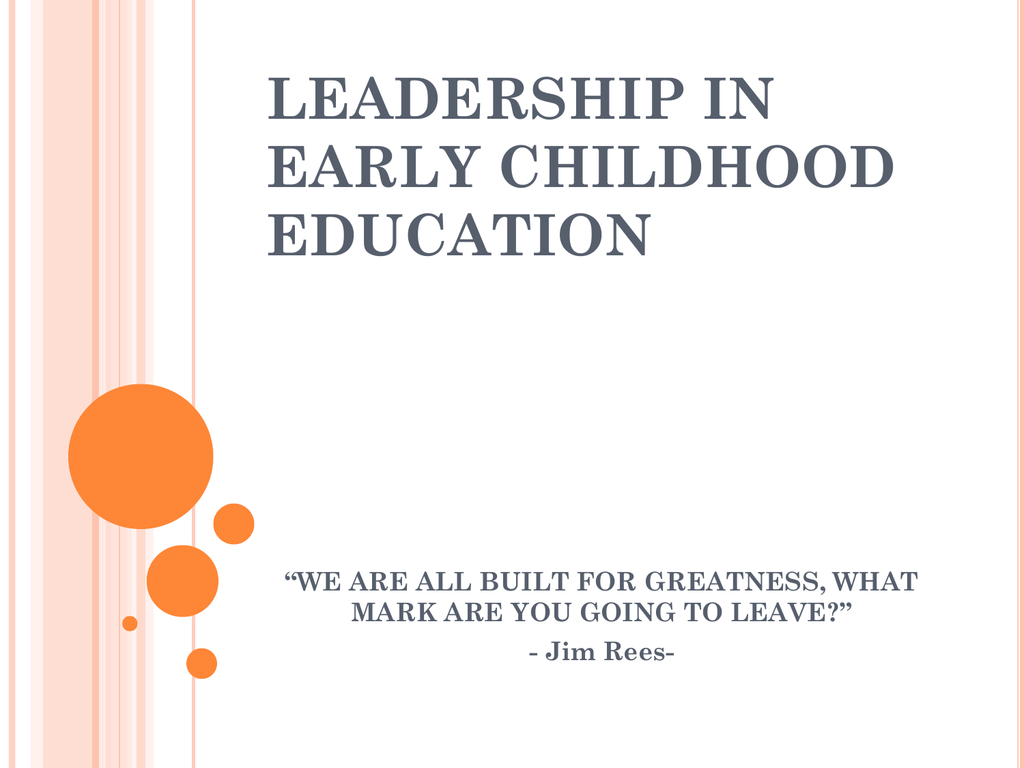Leadership in ece – Leadership in early childhood education (ECE) stands as a pivotal force, shaping the lives of young learners. It encompasses a unique blend of responsibilities, qualities, and skills that drive positive outcomes for children’s development and learning.
Effective ECE leaders foster nurturing environments where children can thrive, instilling a love for learning and laying the foundation for future success.
Definition of Leadership in Early Childhood Education (ECE)

Leadership in Early Childhood Education (ECE) encompasses the ability to inspire, guide, and support young children, their families, and the professionals who work with them. Unlike leadership in other educational settings, ECE leadership focuses on creating a nurturing and developmentally appropriate environment that fosters children’s holistic growth and well-being.
ECE leaders play crucial roles in:
- Establishing a positive and inclusive learning environment
- Guiding curriculum development and implementation
- Supporting and mentoring staff
- Collaborating with families and the community
- Advocating for policies and resources that support young children
Importance of Leadership in ECE
Leadership plays a pivotal role in the development and success of early childhood education (ECE) programs. Effective leadership fosters a positive and supportive learning environment that promotes children’s cognitive, social, and emotional growth.
Impact on Children’s Development and Learning
- Enhanced cognitive skills:Strong leadership promotes a curriculum that emphasizes critical thinking, problem-solving, and language development, nurturing children’s cognitive abilities.
- Improved social and emotional well-being:Leadership creates a nurturing environment where children feel safe, respected, and encouraged to interact positively with peers and adults, fostering their social and emotional development.
- Increased motivation and engagement:Effective leaders inspire and motivate staff, creating a positive work environment that translates into increased engagement and motivation in children.
Role in Creating a Positive and Supportive Learning Environment
- Establishing clear expectations and goals:Leadership provides clear direction and establishes achievable goals, ensuring that all staff members are working towards a common vision for children’s learning and development.
- Fostering collaboration and teamwork:Effective leaders promote collaboration among staff, parents, and the community, creating a supportive network that benefits children.
- Providing professional development opportunities:Leadership recognizes the importance of ongoing professional development and provides opportunities for staff to enhance their knowledge and skills, benefiting children’s learning.
Qualities and Skills of Effective ECE Leaders

Effective ECE leaders possess a unique blend of qualities and skills that enable them to create positive and nurturing learning environments for young children. These attributes contribute to their ability to inspire and guide their teams, foster collaboration, and promote children’s well-being and development.
Essential Qualities
- Empathy and Understanding:ECE leaders must have a deep understanding of children’s perspectives, emotions, and needs.
- Patience and Resilience:They must remain calm and composed in challenging situations and demonstrate resilience in the face of setbacks.
- Passion and Dedication:A genuine love for children and a commitment to their well-being is essential.
- Integrity and Trustworthiness:Leaders must be ethical, honest, and accountable in their actions.
Key Skills
- Communication and Interpersonal Skills:Effective leaders are excellent communicators who can build strong relationships with children, families, and colleagues.
- Organizational and Planning Skills:They can manage their time and resources efficiently, prioritize tasks, and plan and implement programs.
- Collaboration and Teamwork:Leaders foster a collaborative environment, encouraging teamwork and valuing diverse perspectives.
- Reflective Practice:They continuously evaluate their own practices and seek opportunities for professional development.
- Advocacy and Leadership:They advocate for children’s needs and promote policies and practices that support their well-being.
Leadership Styles in ECE

Leadership styles in ECE vary depending on the individual leader and the context of the setting. Different styles can be effective in different situations, so it is important for leaders to be adaptable and able to use a variety of approaches.
Some of the most common leadership styles used in ECE settings include:
Democratic Leadership
- Democratic leaders involve their staff in decision-making and encourage participation from all members of the team.
- This style can be effective in creating a sense of ownership and buy-in among staff, and it can help to foster a positive and collaborative work environment.
- However, democratic leadership can be time-consuming and it can be difficult to reach a consensus on decisions.
Authoritarian Leadership
- Authoritarian leaders make decisions on their own and do not typically consult with their staff.
- This style can be effective in situations where quick decisions need to be made or where there is a clear hierarchy in place.
- However, authoritarian leadership can be demotivating for staff and it can lead to a lack of creativity and innovation.
Laissez-Faire Leadership
- Laissez-faire leaders give their staff a great deal of autonomy and do not provide much direction or support.
- This style can be effective in situations where staff are highly motivated and self-directed.
- However, laissez-faire leadership can lead to a lack of accountability and it can be difficult to ensure that staff are meeting the needs of the children.
Transactional Leadership
- Transactional leaders focus on rewards and punishments to motivate their staff.
- This style can be effective in the short term, but it can lead to a lack of intrinsic motivation and it can be difficult to sustain over time.
Transformational Leadership
- Transformational leaders inspire their staff to go above and beyond their expectations and to work towards a common goal.
- This style can be effective in creating a highly motivated and engaged workforce.
- However, transformational leadership can be difficult to sustain and it can be challenging to find leaders who possess the necessary skills and qualities.
No one leadership style is perfect for all situations. The best leaders are able to adapt their style to meet the needs of their staff and the context of the setting.
Leadership in early childhood education (ECE) is a critical aspect for fostering children’s development and learning. An MBA in Organizational Leadership can provide ECE leaders with the knowledge and skills needed to effectively manage and lead their organizations, including strategic planning, financial management, and stakeholder engagement.
By enhancing their leadership abilities, ECE leaders can create a positive and supportive environment for both children and staff, ultimately promoting the overall well-being and success of the early childhood education program.
Challenges and Opportunities for ECE Leaders

ECE leaders face unique challenges, including:
- Managing limited resources with high expectations
- Balancing multiple roles and responsibilities
- Addressing the diverse needs of children and families
- Navigating changing regulations and policies
- Maintaining a positive and supportive work environment
Despite these challenges, ECE leaders have ample opportunities for professional development and growth:
Professional Development Opportunities
- Conferences and workshops
- Online courses and webinars
- Mentoring and coaching programs
- Leadership development programs
- Collaboration with other professionals
Growth Opportunities
- Assuming additional leadership roles within the organization
- Becoming involved in policy development and advocacy
- Mentoring and supporting other ECE professionals
- Conducting research and presenting at conferences
- Publishing articles and books
Best Practices in ECE Leadership

Effective leadership in ECE involves implementing best practices that foster a positive and supportive environment for children, families, and staff. These practices empower leaders to create a vision, inspire collaboration, and drive continuous improvement.
Leadership in early childhood education (ECE) plays a crucial role in shaping the development and learning outcomes of young children. If you’re interested in pursuing a career in ECE leadership, consider exploring eds in educational leadership. These programs provide advanced knowledge and skills in educational theory, leadership practices, and research methods, equipping you to effectively lead and manage ECE programs and initiatives.
Creating a Shared Vision and Goals
- Engage stakeholders (staff, families, community) in developing a shared vision and mission for the program.
- Establish clear goals and objectives that align with the program’s philosophy and values.
- Communicate the vision and goals effectively to all stakeholders, ensuring everyone is working towards the same outcomes.
Fostering Collaboration and Teamwork, Leadership in ece
- Create a culture of respect, trust, and open communication among staff members.
- Encourage collaboration and teamwork by providing opportunities for staff to share ideas and work together.
- Establish clear roles and responsibilities for staff, empowering them to contribute effectively to the team.
Supporting Professional Development
- Provide ongoing professional development opportunities for staff to enhance their knowledge, skills, and practices.
- Support staff in pursuing higher education or specialized training to advance their careers.
- Create a culture of learning and continuous improvement, encouraging staff to reflect on their practice and seek ways to grow.
Building Strong Relationships with Families
- Establish open and effective communication channels with families to build strong relationships.
- Involve families in their children’s education and decision-making processes.
- Create opportunities for families to participate in program activities and events.
Promoting Inclusivity and Diversity
- Create a welcoming and inclusive environment that respects and values all children, families, and staff.
- Promote diversity in hiring practices and ensure that staff reflects the community served.
- Implement anti-bias and anti-discrimination policies and practices to foster an equitable environment.
Advocating for Children and Families
- Advocate for policies and resources that support early childhood education and care.
- Represent the needs of children and families at the local, state, and national levels.
- Collaborate with community organizations and agencies to provide comprehensive services to children and families.
Future Trends in ECE Leadership
The field of early childhood education (ECE) is constantly evolving, and the role of leadership is no exception. As the ECE landscape continues to change, so too must the way that leaders approach their work. In this section, we will explore some of the emerging trends and future directions in ECE leadership.
If you’re passionate about leadership in early childhood education, pursuing an MS in Educational Leadership can elevate your career. This advanced degree provides specialized knowledge and skills essential for effective leadership in ECE settings, enabling you to create positive learning environments and support the development of young children.
One of the most significant trends in ECE leadership is the increasing focus on equity and inclusion. In the past, ECE programs were often designed to serve children from a narrow range of backgrounds. However, today’s ECE leaders are recognizing the importance of creating programs that are welcoming and supportive of all children, regardless of their race, ethnicity, gender, ability, or socioeconomic status.
Another trend in ECE leadership is the growing emphasis on data-driven decision-making. In the past, ECE leaders often made decisions based on their intuition or experience. However, today’s leaders are increasingly using data to inform their decisions. This data can come from a variety of sources, such as child assessments, parent surveys, and staff observations.
Implications of Future Trends for the Field of ECE
The emerging trends in ECE leadership have a number of implications for the field of ECE. First, they suggest that ECE leaders need to be more focused on equity and inclusion. Second, they suggest that ECE leaders need to be more data-driven in their decision-making.
Third, they suggest that ECE leaders need to be more collaborative in their work.
Last Recap

In the ever-evolving landscape of ECE, leaders play a critical role in navigating challenges and seizing opportunities. By embracing best practices, developing their skills, and staying abreast of emerging trends, they continue to elevate the quality of early childhood education, ensuring that every child has the chance to reach their full potential.
Quick FAQs
What are the key responsibilities of an ECE leader?
ECE leaders are responsible for managing staff, creating and implementing curriculum, ensuring a safe and nurturing learning environment, and advocating for children and families.
What qualities make an effective ECE leader?
Effective ECE leaders possess empathy, patience, strong communication skills, a deep understanding of child development, and a commitment to lifelong learning.
How can ECE leaders promote positive learning environments?
ECE leaders create positive learning environments by fostering open communication, encouraging collaboration, providing resources, and celebrating diversity.